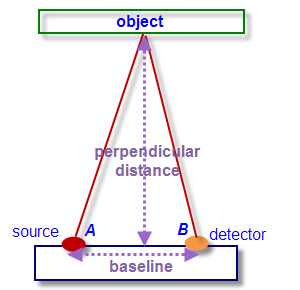In our last news post, we talked about Coroware’s new laser rangefinder. We also know that the Neato XV-11, one of the Roomba’s promising competitors so far, relies on an inexpensive but reliable laser rangefinder. So what is a laser rangefinder and how is it used in robotics?
Time of Flight
A laser rangefinder, as the name suggests, is a device whose main component is a laser. The laser is beamed to an object, bounced off it, and captured by a receiver/detector. The purpose is to measure the distance between the device and the object.
One way to do this is by applying the ‘time of flight’ principle.
The ‘time of flight’ principle is so called because it makes use of the duration over which the light pulse of the laser travels from the device to the object and back. This principle also needs the speed of light, which is a known value – about 300,000,000 m/s. Once the time of flight is measured, the distance can be computed using the two known values.
Relative speeds between the object and the device can also be measured by means of the Doppler effect. The accuracy of the readings is dependent on the presence of impurities in the air, the temperature of the air, and other obstructions.
The applications of laser rangefinders range from outdoor sports like golf, hunting, and archery; military targeting systems including those for fighter planes, UAVs, and human ground troops (these look like binoculars); to 3D modeling; and of course (the reason why we’re mentioning it here) robotics.
Not all laser rangefinders rely on the time of flight principle. Others use the triangulation method instead.
Triangulation
The triangulation method is one of the oldest and most reliable ways of determining distances. It is the basic method used by surveyors, e.g. in measuring the distance across a river, or even by astronomers in measuring the distance between stars (although ‘parallax’ is the more appropriate term).
The method simply needs two observers, each focused on the same object. So, if you draw imaginary lines joining them and the observed object, you’ll form a triangle. The length of the line joining the two observers, known as the baseline, should be known.
Once the angles of the triangle at each observer is determined, the perpendicular distance from the baseline to the object can be computed using simple trigonometry. An illustration is shown below.
In a laser rangefinder, the device itself takes the role of both observers. The light (or laser) source is one observer, while a detector on the device is the other observer. It is assumed that the distance between them is known. When a pulse is sent in the direction of the object, the angle at the source is measured. Subsequently, when the pulse is received by the detector, the angle there is also measured.
 Here’s a simplified illustration. A and B are the angles. Try to imagine how the angles will change if the object is located nearer or farther. For a nearer object, the angles will get smaller but for a farther object, the angles will get larger. Again, the baseline (which is constant) is known. Once the angles are determined, the corresponding perpendicular distance between the detector and the object can be computed.
Here’s a simplified illustration. A and B are the angles. Try to imagine how the angles will change if the object is located nearer or farther. For a nearer object, the angles will get smaller but for a farther object, the angles will get larger. Again, the baseline (which is constant) is known. Once the angles are determined, the corresponding perpendicular distance between the detector and the object can be computed.
to be continued …



Going through the article, what I understood is that laser range finder works like as our optical mouse. But I have few confusion as well. Will there be delay timer to calculate the delay of reflected laser beam from the obstacle and how is relative speed of laser beam affected by the temperature of the surrounding ?
I don’t think that Neato is the first manufacturer which adds to their robot rangefinder. Samsung adds to theirs sth. similar. Their robots has sth to detect too low sofas to prevents it becoming stuck and to detect door.
Pretty cool stuff, and very inexpensive on Neato’s side. Hopefully, that will help bring down the high cost of the other competitors to where more roboticists have the opportunity to purchase them (If needed).